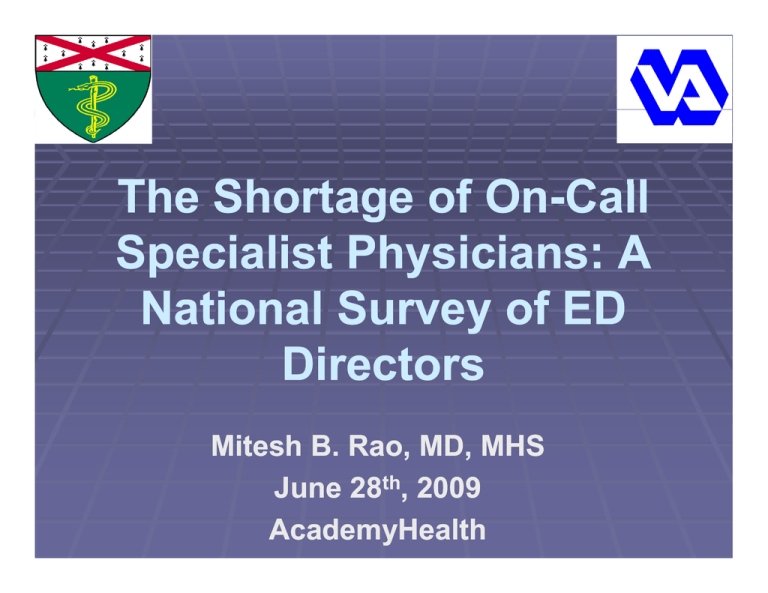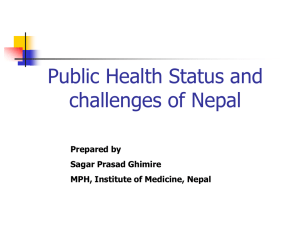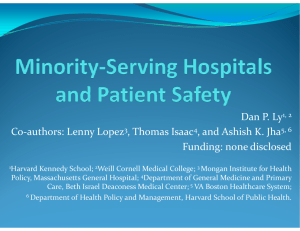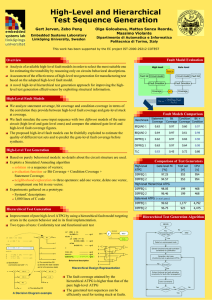Th Sh t f O C ll
advertisement

Th Shortage The Sh t off OnOn O -Call C ll Specialist Physicians: A National Survey y of ED Directors Mitesh B. Rao, Rao, MD, MHS June 28th, 2009 AcademyHealth EM ERG EN CY DEPARTM Se rv ices Availa ble Frac tu re s D slo ca tio ns Di Is ch em ic Stro ke Ca rd ia c Arre st 1 st Trim es te r Bleed An te rio r No se Blee d ENT Serv ic es NO T Availa ble Frac tu rere Dislo ca c tio ti ns Te nd on La ce ra tio ns He m orrh ag ic Stro ke GI Blee d 3 rd Trim es te r Prob le m s Po sterio r No ossee Blee d An estimated 21% of Emergency Department patient death and permanent injury can be attributed to delays in treatment linked to shortages in specialist physicians physicians* *Sentinel Event Alert, No. 26, The Joint Commission (June 17th, 2002) Objectives To report the experiences of Emergency Department (ED) directors regarding: The degree of difficulty in providing specialist coverage The impact p of onon-call coverage g shortages g on emergency patient care The shortage of onon-call coverage for specific specialties The difference in impact of onon-call shortages to teaching and nonnon-teach institutions Study Design Cross sectional self self--administered survey of a sample of all ED directors in the 48 contiguous United States. Survey design based on prior studies and further developed based on: Review of the literature Input from leaders from the American g of Emergency g y Physicians y and College the American College of Surgeons Population 750 hospitals p drawn from all institutions across the 48 contiguous states Sample S l stratified t tifi d b by even di distribution t ib ti across all states, in proportion to variation in numbers of facilities per state. Names of hospitals p and their ED directors along with addresses and phone numbers were obtained from a vendor of hospital marketing data Exclusion Criteria Excluded facilities that do not offer fullfullservice emergency medical care to the general p g public Federally owned hospitals Pediatric and women’s women s hospitals Specialty longlong-term hospitals Final sample consisted of 715 hospitals Instrument Survey addressed presence of onon-call specialist shortages overall as well as by specialty Surgical specialties specifically identified: General Surgery Trauma Surgery Neurosurgery Plastic Surgery g y Hand Surgery Orthopedics Instrument Examined potential effects of onon-call surgical shortages: Whether onon-call shortages affected the hospital’s h i l’ trauma llevell Changes in number of patients leaving b f before b being i seen b by a medicallymedically di ll -needed d d specialist Reliability of current onon-call specialists Recent losses in 24/7 coverage for a specialty Changes in ED transfer rates Administration Mailed to ED Directors in winter of 2008 Employed modified fivefive-wave contact strategy to ensure acceptable response rate Final survey response rate of 62% Respondents representative representati e of ac acute acutete-care U.S. hospitals Analysis Analyzed using SAS 9.1 9 1 Statistical Software Demographic information on participating hospitals collected via the American Hospitals Directory website Bivariate analyses between reported measures of the onon-call problem and hospital (trauma level level, ownership ownership, teaching status) and geographic variables (geographic region, rural/urban)) P-Values: Trauma: 0.03 Teaching: 0.03 MSA 0 MSA: 0.9 9 Reported On-Call Problem 80% 70% 60% 50% 40% 72% 30% 60% 55% T rauma Level I T rauma Level II 74% 66% LLevell III o r less T eaching hi Hosp it al 76% 72% N o nT eaching Ho spit al U rbb an 72% 20% 10% 0% Overallll O Sample R urall Effect of On-Call Shortages on Emergency Care 70% 60% 50% 40% 30% 61% 20% 10% 0% 23% Lost Trauma Designation Suspended/Lost 24% 26% Increase in Patients Unreliability of Current Loss of Ability to Leaving Before Being On-Call On Call Specialists Provide 24/7 Coverage Seen for a Specialty Problems With On-Call Coverage by Specialty Specialty Not Represented Dfficulty Maintaining On-Call Services 90% 80% 70% 60% 25% 25% 55% 57% 34% 50% 10% 37% 40% 30% 7% 20% 41% 40% 30% 28% 10% 0% General Surgery Orthopedic Surgery Trauma Surgery Neurosurgery Hand Surgery Plastic Surgery Teaching vs. Non-Teaching Hospitals 60% % 50% 40% 57% 30% Teaching Non-Teaching 42% 20% 37% 28% 10% 14% 17% 0% Traum a Level Affected Increasing Transfers To ED Increasing Transfers From ED P-Values all <0.01 Conclusions More critical critical--need patients leaving before being seen for higherhigher-level care Increasing attrition of specialist coverage Unreliability and inadequacy in current call coverage Conclusions Non Non--teaching and lower trauma trauma--level hospitals: Suffer more from onon-call shortages g Face traumatrauma-level downgrades/suspensions g p Teaching hospitals: Overburdened with increasing numbers of incoming patient transfers Next Steps… Additional analysis on: Current and future management of onon-call coverage Efficacy of current solutions Perspectives Perspecti es on potential ffuture t re sol solutions tions “Roadblocks” to change A Special Thanks To… The U.S. Department of Veteran Affairs The Robert Wood Johnson Clinical Scholars Program and Foundation Our Funders: Connecticut Chapter p of the American College of Surgeons Connecticut College of Emergency Physicians American College of Emergency Physicians Appendix Responders versus NonNon-Responders Variable Responders (%) Non Non--Responders (%) Level 1 30 (6.8) 7 (2.6) Level 2 30 ((6.8)) 21 ((7.7)) 381 (86.4) 246 (89.8) Yes 150 (34.3) 66 (24.7) No 287 (65.7) 201 (75.3) Northeast 75 (17.0) 13 (4.7) South 186 (42.2) 93 (33.9) Midwest 112 (25.4) 95 (34.7) West 68 (15.4) 73 (26.6) Yes 283 (64.5) 142 (52.0) No 156 (35.5) 131 (48.0) T Trauma Level L l Level 3 or less Teaching Geography MSA Variable (N) On On--Call Problem (N), (%) Overall Sample 437 315 (72.1) Trauma Level P-Value 0.02 I 30 18 (60.0 II 29 16 (55.2) III or less 380 282 (74.2) Teaching Hospital 0.03 Yes 149 98 (65.8) No 286 217 (75.9) (75 9) Geographic Region <0.01 Northeast 73 56 (76.9) South 186 147 (79.0) (79 0) Midwest 112 67 (59.8) West 68 46 (67.7) Metropolitan Statistical Area 0.90 0 90 Urban 281 202 (71.9) Rural 156 113 (72.4) H Hospital it l Ownership O hi 0.72 0 72 Voluntary Nonprofit 260 184 (70.8) Governmental 99 73 (73.7) 72 54 (75 0) P i t Variable Inadequate On On--call Coverage Adequate OnOn-Call Coverage Affected trauma designation P-Value <0.01 Yes 87 (27 (27.9) 9) 13 (10 (10.9) 9) No/Does not apply 225 (72.1) 106 (89.1) Patients leave after initial evaluation <0.01 Increase 84 (28.7) 11 (10.1) Decrease 14 (4.8) 8 (7.3) 195 (66.6) 90 (82.6) Stay the same Number of transfers to ED 0.01 Increase 67 (21.8) 38 (35.9) Decrease 7 (2.3) 1 (0.9) 233 (75.9) 67 (63.2) Stay the same Number of transfers from ED <0.01 Increase 178 (58.4) 33 (28.0) Decrease 8 (2.6) 8 (6.8) 119 (39.0) 77 (65.3) Stay the same Reliable onon-call specialists? <0.01 All/most of the time 214 (68.8) 105 (89.7) Some of the time/rarely 97 (31 (31.2) 2) 12 (10 (10.3) 3) Lost ability to provide 24/7 coverage <0.01 Yes 221 (72.2) 37 (32.2) No 85 (27.8) 78 (67.8) Variable Overall (%) Teaching (%) NonNon-Teaching (%) Affected trauma designation <0.01 Yes 101 (23.3) 21 (14.2) 79 (28.1) No/Does not apply 332 (76.7) 127 (85.8) 202 (71.9) Patients leave after initial evaluation 0.81 Increase 95 (23.5) 32 (23.7) 63 (23.7) Decrease 22 (5.5) 6 (4.4) 16 (6.0) 287 (71.0) 95 (71.9) 187 (70.3) Stay the same Number of transfers to ED <0.01 Increase 105 (25 (25.3) 3) 59 (41 (41.6) 6) 46 (17 (17.0) 0) Decrease 8 (1.9) 3 (2.1) 5 (1.9) 302 (72.8) 80 (56.3) 219 (81.1) Stay the same Number of transfers from ED <0 01 <0.01 Increase 212 (49.9) 53 (36.8) 159 (57.4) Decrease 16 (3.8) 9 (6.3) 6 (2.2) 196 (46.4) 82 (56.9) 112 (40.4) Stay the same P-Value Reliable onon-call specialists? 0.72 All/most of the time 319 (74.2) 111 (75.0) 204 (73.4) Some of the time/rarely 111 (25.8) 37 (25.0) 74 (26.6) Lost ability to provide 24/7 coverage 0.51 Yes 259 (61.2) 93 (63.7) 165 (60.4) No 164 (38.8) 53 (36.3) 108 (39.6)





